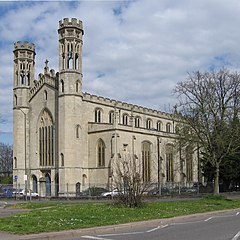Trinity Centre
| Trinity Centre | |
|---|---|
 |
|
|
Location within Bristol
|
|
| General information | |
| Town or city | Bristol |
| Country | England |
| Coordinates | 51°27′29″N 2°34′34″W / 51.45809°N 2.57617°W |
| Construction started | 1829 |
| Completed | 1832 |
| Design and construction | |
| Architect | Thomas Rickman and Henry Hutchinson |
The Trinity Centre, formerly the Holy Trinity Church, in Lawrence Hill, Bristol is designated by English Heritage as a grade II* listed building. The building is protected by a covenant, which states that it is to only be used for community, arts, youth and education services. This covenant has influenced much of the building's recent use as an arts and community venue.
The church was built between 1829 and 1832 by Thomas Rickman and Henry Hutchinson, two architects from Birmingham, who also designed the piers, perimeter walls and railings which are also listed.
The church is built using Bath stone in a Perpendicular style, a style of English Gothic architecture characterised by its strong emphasis on the vertical elements and its linear design.
It has two octagonal bell towers with open turrets on the west face of the building. The towers sit on either side of the main entrance and the west window. During a period when the building sat empty, the bells were taken and either sold for scrap or to another church. The towers now sit empty and are occupied only by bats and pigeons.
The original bells and fittings were replaced with new ones in April 1927. The work was carried out by local firm Llewellins & James Ltd of Castle Green. It cost £47 10s for bells and labour although an additional £3 10s was incurred when the workmen realised that they had to remove the floor of the towers to get the new bells in.
The Holy Trinity Church had 2,200 seats with 1,500 of these being free.
The Napoleonic War against France, which had raged for 12 years ended in 1815, with the defeat of Emperor Napoleon Bonaparte at the Battle of Waterloo. With victory came money for Britain and her allies.
In 1818, £1,000,000 was given by Parliament to build new churches across the country. In 1824, a further £500,000 was given to continue with the mass build. The acts became known as the 'Million' and 'Half Million' Acts. Churches built as a result of these acts became known as 'Million', 'Half Million', or Waterloo churches.
...
Wikipedia

